Attached files
| file | filename |
|---|---|
| 8-K - 8-K - FAIRPOINT COMMUNICATIONS INC | a8k-9215.htm |
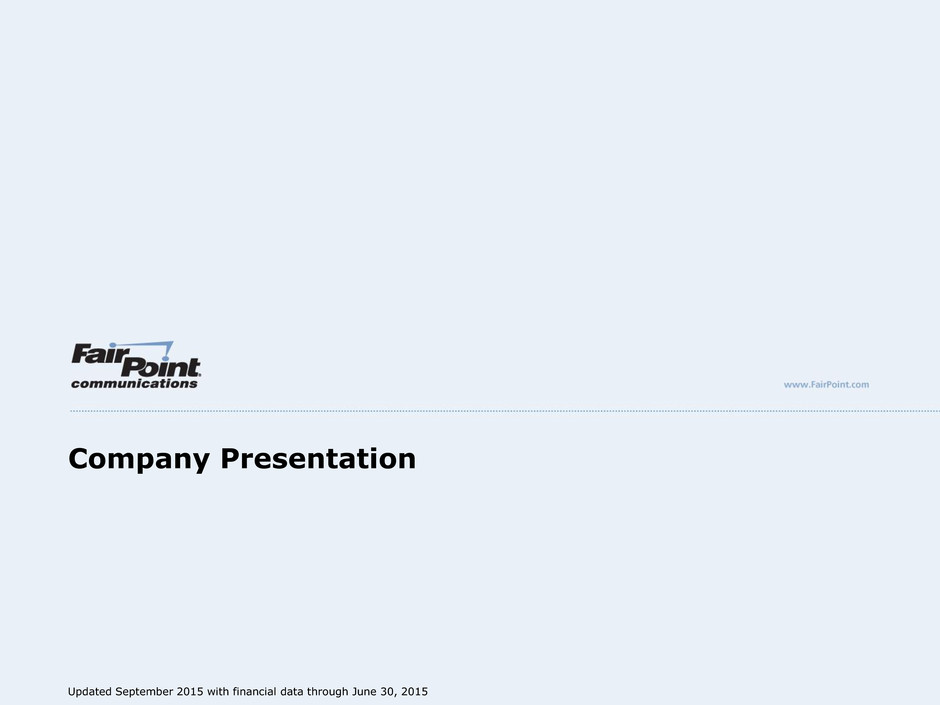
Updated September 2015 with financial data through June 30, 2015 Company Presentation

2 Safe Harbor Statement The information contained herein is current only as of the date hereof; however, unless otherwise indicated, financial information contained herein is as of June 30, 2015. The business, prospects, financial condition or performance of FairPoint Communications, Inc. (“FairPoint”) and its subsidiaries described herein may have changed since that date. FairPoint does not intend to update or otherwise revise the information contained herein. FairPoint makes no representation or warranty, express or implied, as to the completeness of the information contained herein. Market data used throughout this presentation is based on surveys and studies conducted by third parties, as well as industry and general publications. FairPoint has no obligation (express or implied) to update any or all of the information or to advise you of any changes; nor does FairPoint make any express or implied warranties or representations as to the completeness or accuracy nor does it accept responsibility for errors. Some statements herein are known as “forward-looking statements” within the meaning of Section 27A of the Securities Act of 1933, as amended, and Section 21E of the Securities Exchange Act of 1934, as amended. These forward-looking statements include, but are not limited to, statements about our plans, objectives, expectations and intentions and other statements contained herein that are not historical facts. When used herein, the words “expects,” “anticipates,” “intends,” “plans,” “believes,” “seeks,” “estimates,” “projects,” “continue,” “outlook” and similar expressions are generally intended to identify forward-looking statements. Because these forward-looking statements involve known and unknown risks and uncertainties, there are important factors that could cause actual results, events or developments to differ materially from those expressed or implied by these forward-looking statements, including our plans, objectives, expectations and intentions and other factors, including those factors discussed under “Risk Factors” in our Annual Report on Form 10-K for the fiscal year ended December 31, 2014 and other factors discussed in reports that we file with the Securities and Exchange Commission. You should not place undue reliance on such forward-looking statements, which are based on the information currently available to us and speak only as of the date hereof. FairPoint does not undertake any obligation to publicly update or revise any forward-looking statements, whether as a result of new information, future events or otherwise. We provide guidance as to certain financial information herein, which consists of forward-looking statements. Our guidance is not prepared with a view toward compliance with the published guidelines of the American Institute of Certified Public Accountants, and neither our independent registered public accounting firm nor any other independent expert or outside party compiles or examines the guidance and, accordingly, no such person expresses any opinion or any other form of assurance with respect thereto. Guidance is based upon a number of assumptions and estimates that, while presented with numerical specificity, are inherently subject to significant business, economic and competitive uncertainties and contingencies, many of which are beyond our control and are based upon specific assumptions with respect to future business decisions, some of which will change. We generally state possible outcomes as high and low ranges which are intended to provide a sensitivity analysis as variables are changed but are not intended to represent our actual results which could fall outside of the suggested ranges. The principal reason that we release this data is to provide a basis for our management to discuss our business outlook with analysts and investors. Notwithstanding this, we do not accept any responsibility for any projections or reports published by any such outside analysts or investors. Guidance is necessarily speculative in nature, and it can be expected that some or all of the assumptions or the guidance furnished by us will not materialize or will vary significantly from actual results. Accordingly, our guidance is only an estimate of what management believes is realizable as of the date hereof. Actual results may vary from the guidance and the variations may be material. Investors should also recognize that the reliability of any forecasted financial data diminishes the farther in the future that the data is forecast. In light of the foregoing, investors are urged to put the guidance in context and not to place undue reliance on it. Any inability to successfully implement our operating strategy or the occurrence of any of the events or circumstances discussed therein could result in the actual operating results being different than the guidance, and such differences may be material.

3 Non-GAAP Financial Measures The Company uses certain non-GAAP financial measures in evaluating its performance. Throughout this presentation, reference is made to Adjusted EBITDA, Adjusted EBITDA minus Estimated Avoided Costs, Unlevered Free Cash Flow, Unlevered Free Cash Flow minus Estimated Avoided Costs and adjustments to GAAP and non-GAAP measures to exclude the effect of special items. Management believes the non-GAAP measures are useful for investors because they enable them to view performance in a manner similar to the method used by the Company’s management. Unlevered Free Cash Flow and Unlevered Free Cash Flow minus Estimated Avoided Costs may also be useful to investors in assessing the Company’s ability to generate cash and meet its debt service requirements. The maintenance covenants contained in the Company’s credit facility are based on Adjusted EBITDA. In addition, management believes that the adjustments to GAAP and non-GAAP measures to exclude the effect of special items may be useful to investors in understanding period- to-period operating performance and in identifying historical and prospective trends. On October 17, 2014, two of our labor unions in northern New England initiated a work stoppage. As a result, significant union employee and vehicle and other related expenses related to northern New England were not incurred between October 17, 2014 and February 24, 2015 (the "work stoppage period"). Therefore, to assist in the evaluation of the Company's operating performance without the impact of the work stoppage, we estimated the union employee and vehicle and other related expenses using historical data for the work stoppage period that we believe would have been incurred absent the work stoppage ("Estimated Avoided Costs"). Estimated Avoided Costs is a pro forma estimate only. The non-GAAP financial measures, as used herein, are not necessarily comparable to similarly titled measures of other companies. Furthermore, these non-GAAP measures have limitations as analytical tools and should not be considered in isolation from, or as an alternative to, net income or loss, operating income, cash flow or other combined income or cash flow data prepared in accordance with GAAP. Because of these limitations, Adjusted EBITDA, Adjusted EBITDA minus Estimated Avoided Costs, Unlevered Free Cash Flow, Unlevered Free Cash Flow minus Estimated Avoided Costs should not be considered as measures of discretionary cash available to invest in business growth or reduce indebtedness. The Company compensates for these limitations by relying primarily on its GAAP results and using the non-GAAP measures only supplementally. A reconciliation of Net Income (Loss) to Adjusted EBITDA, Adjusted EBITDA minus Estimated Avoided Costs, Unlevered Free Cash Flow, and Unlevered Free Cash Flow minus Estimated Avoided Costs can be found in the appendix of this presentation. The information in this document should be read in conjunction with the financial statements and footnotes contained in our documents filed with the U.S. Securities and Exchange Commission.
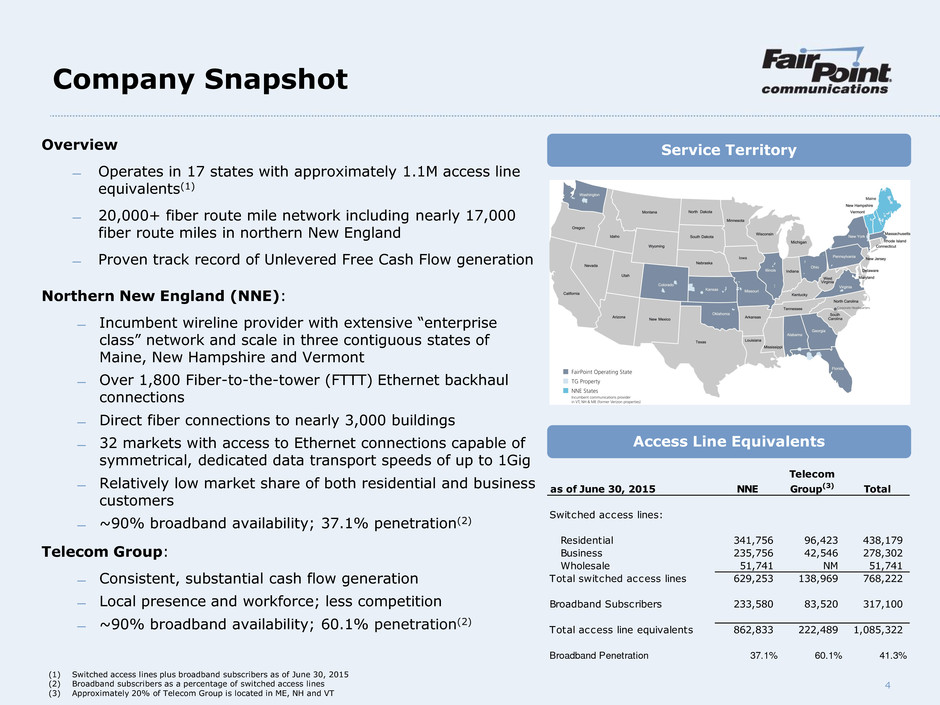
4 Access Line Equivalents Company Snapshot Overview ̶ Operates in 17 states with approximately 1.1M access line equivalents(1) ̶ 20,000+ fiber route mile network including nearly 17,000 fiber route miles in northern New England ̶ Proven track record of Unlevered Free Cash Flow generation Northern New England (NNE): ̶ Incumbent wireline provider with extensive “enterprise class” network and scale in three contiguous states of Maine, New Hampshire and Vermont ̶ Over 1,800 Fiber-to-the-tower (FTTT) Ethernet backhaul connections ̶ Direct fiber connections to nearly 3,000 buildings ̶ 32 markets with access to Ethernet connections capable of symmetrical, dedicated data transport speeds of up to 1Gig ̶ Relatively low market share of both residential and business customers ̶ ~90% broadband availability; 37.1% penetration(2) Telecom Group: ̶ Consistent, substantial cash flow generation ̶ Local presence and workforce; less competition ̶ ~90% broadband availability; 60.1% penetration(2) (1) Switched access lines plus broadband subscribers as of June 30, 2015 (2) Broadband subscribers as a percentage of switched access lines (3) Approximately 20% of Telecom Group is located in ME, NH and VT Service Territory as of June 30, 2015 NNE Telecom Group(3) Total Switched access lines: Residential 341,756 96,423 438,179 Business 235,756 42,546 278,302 Wholesale 51,741 NM 51,741 Total switched access lines 629,253 138,969 768,222 Broadband Subscribers 233,580 83,520 317,100 Total access line equivalents 862,833 222,489 1,085,322 Broadband Penetration 37.1% 60.1% 41.3%
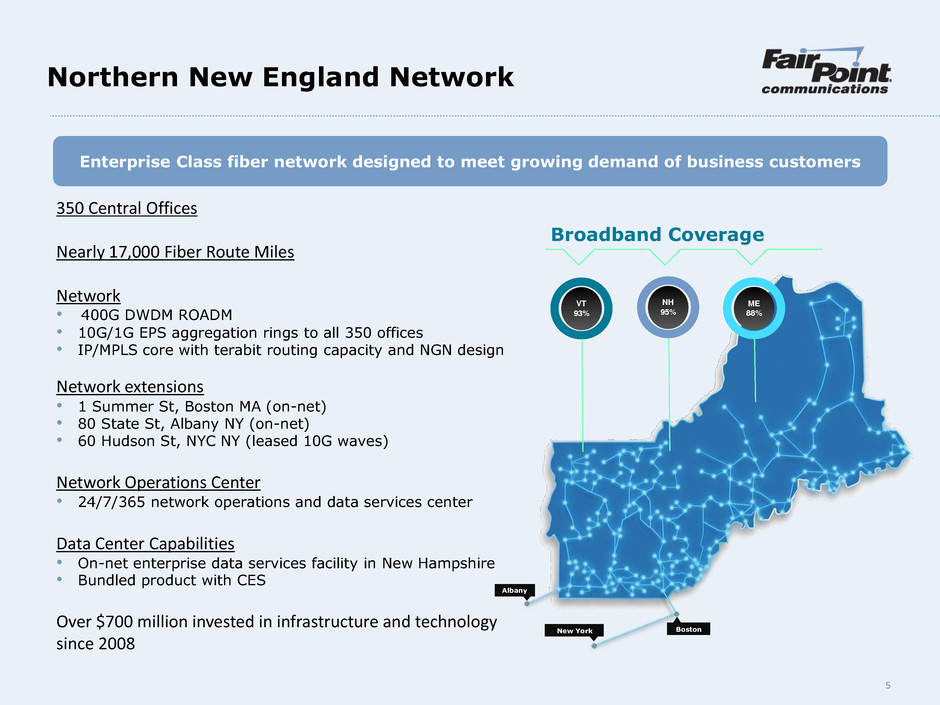
5 Albany Boston Northern New England Network 350 Central Offices Nearly 17,000 Fiber Route Miles Network • 400G DWDM ROADM • 10G/1G EPS aggregation rings to all 350 offices • IP/MPLS core with terabit routing capacity and NGN design Network extensions • 1 Summer St, Boston MA (on-net) • 80 State St, Albany NY (on-net) • 60 Hudson St, NYC NY (leased 10G waves) Network Operations Center • 24/7/365 network operations and data services center Data Center Capabilities • On-net enterprise data services facility in New Hampshire • Bundled product with CES Over $700 million invested in infrastructure and technology since 2008 VT 93% ME 88% NH 95% Broadband Coverage New York Enterprise Class fiber network designed to meet growing demand of business customers
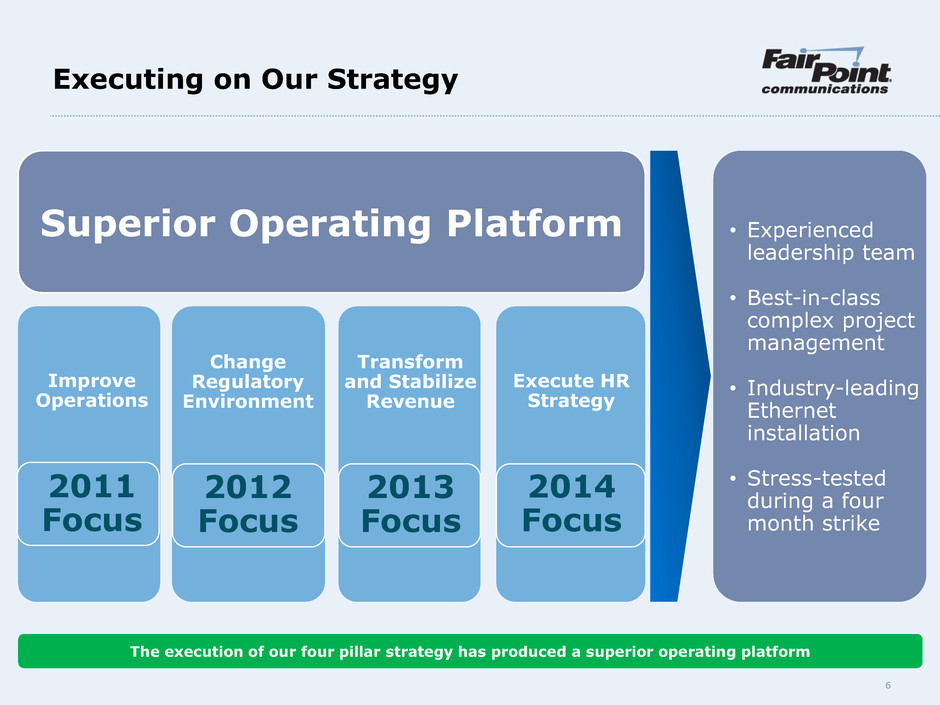
6 Improve Operations 2011 Focus Executing on Our Strategy Change Regulatory Environment 2012 Focus Superior Operating Platform Transform and Stabilize Revenue 2013 Focus Execute HR Strategy 2014 Focus • Experienced leadership team • Best-in-class complex project management • Industry-leading Ethernet installation • Stress-tested during a four month strike The execution of our four pillar strategy has produced a superior operating platform

7 Complex Program Management New England TeleHealth Consortium Maine Schools and Libraries Fiber to the Tower • 350+ locations across the state of Maine • Ethernet Virtual Private Line • Off-net site coordination with access management team • ~1,800 FTTT connections • Ethernet Virtual Private Line on fiber network • All major wireless carriers • Have met all on-time delivery SLA’s to date • 300+ locations across ME, NH and VT Ethernet Virtual Private Line • Mix of fiber and copper delivered solutions • Stringent tracking of all order/circuit information with regularly scheduled customer meetings/reports NG911 • Conversion of Maine E911 system from TDM to IP • 26 PSAPs • Maine was the 1st completely IP based NG911 system in the nation • Completed installation of Vermont NG911 system in July 2015 Partner with Customer Effective Communication Own Project Success • Dedicated Team of 11 Customer Project Managers and 9 IT, Network and Product Project Managers • Highly experienced customer facing team with a proven track record of success • Disciplined and standardized 10 step project implementation approach
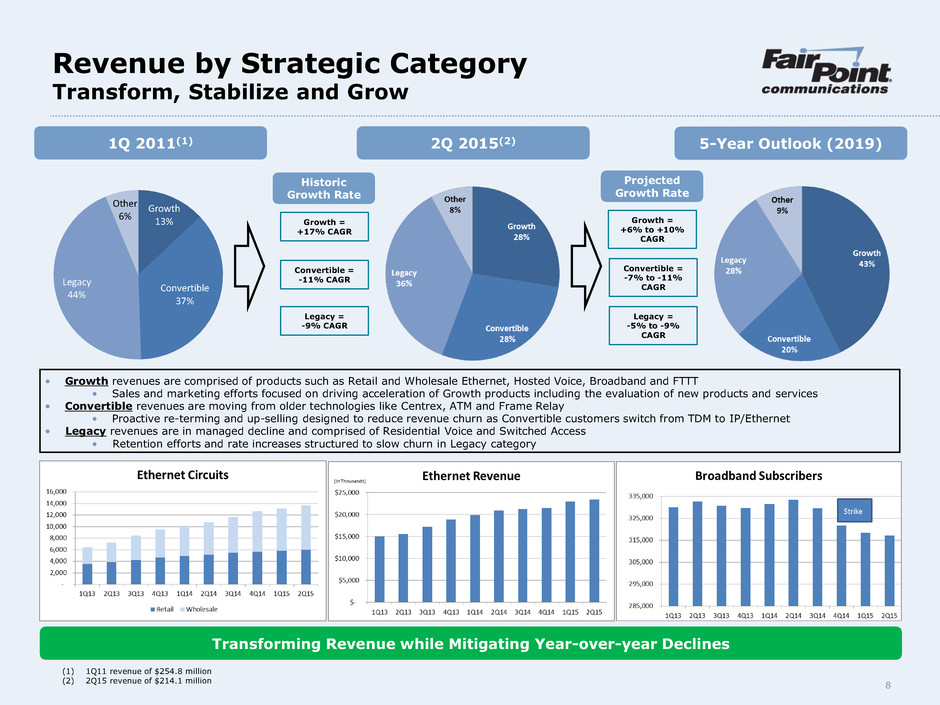
8 Revenue by Strategic Category Transform, Stabilize and Grow • Growth revenues are comprised of products such as Retail and Wholesale Ethernet, Hosted Voice, Broadband and FTTT • Sales and marketing efforts focused on driving acceleration of Growth products including the evaluation of new products and services • Convertible revenues are moving from older technologies like Centrex, ATM and Frame Relay • Proactive re-terming and up-selling designed to reduce revenue churn as Convertible customers switch from TDM to IP/Ethernet • Legacy revenues are in managed decline and comprised of Residential Voice and Switched Access • Retention efforts and rate increases structured to slow churn in Legacy category Transforming Revenue while Mitigating Year-over-year Declines 2Q 2015(2) 5-Year Outlook (2019) Growth = +6% to +10% CAGR Legacy = -5% to -9% CAGR Convertible = -7% to -11% CAGR 1Q 2011(1) Projected Growth Rate Growth 13% Convertible 37% Legacy 44% Other 6% Growth = +17% CAGR Legacy = -9% CAGR Convertible = -11% CAGR Historic Growth Rate (1) 1Q11 revenue of $254.8 million (2) 2Q15 revenue of $214.1 million
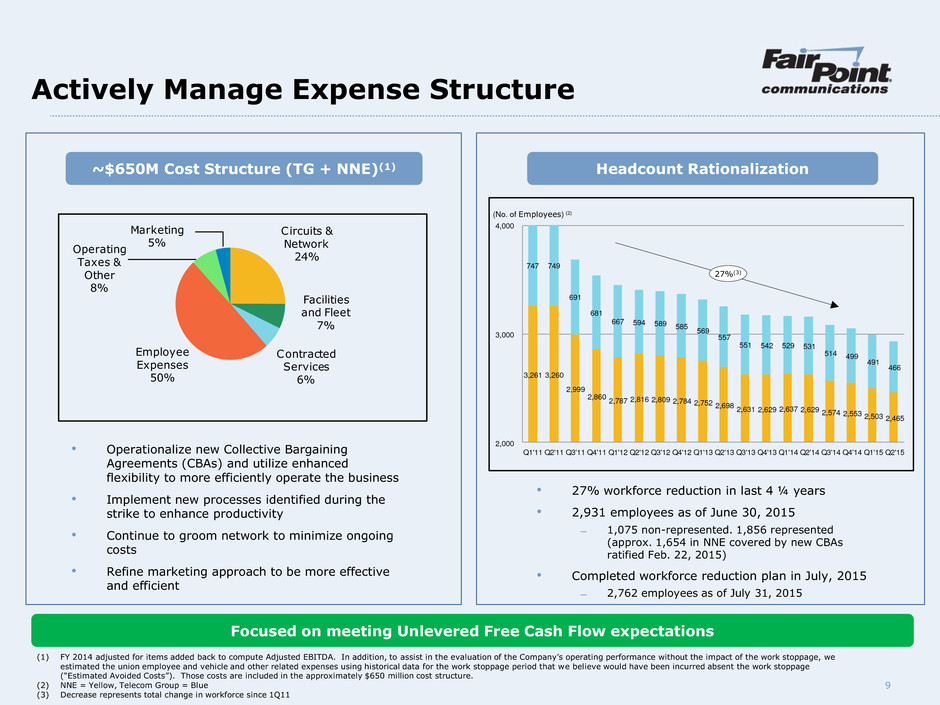
9 Actively Manage Expense Structure Focused on meeting Unlevered Free Cash Flow expectations Circuits & Network 24% Facilities and Fleet 7% Contracted Services 6% Employee Expenses 50% Operating Taxes & Other 8% Marketing 5% 3,261 3,260 2,999 2,860 2,787 2,816 2,809 2,784 2,752 2,698 2,631 2,629 2,637 2,629 2,574 2,553 2,503 2,465 747 749 691 681 667 594 589 585 569 557 551 542 529 531 514 499 491 466 2,000 3,000 4,000 Q1'11 Q2'11 Q3'11 Q4'11 Q1'12 Q2'12 Q3'12 Q4'12 Q1'13 Q2'13 Q3'13 Q4'13 Q1'14 Q2'14 Q3'14 Q4'14 Q1'15 Q2'15 NNE Telecom (No. of Employees) (2) • 27% workforce reduction in last 4 ¼ years • 2,931 employees as of June 30, 2015 ̶ 1,075 non-represented. 1,856 represented (approx. 1,654 in NNE covered by new CBAs ratified Feb. 22, 2015) • Completed workforce reduction plan in July, 2015 ̶ 2,762 employees as of July 31, 2015 Headcount Rationalization 27%(3) ~$650M Cost Structure (TG + NNE)(1) • Operationalize new Collective Bargaining Agreements (CBAs) and utilize enhanced flexibility to more efficiently operate the business • Implement new processes identified during the strike to enhance productivity • Continue to groom network to minimize ongoing costs • Refine marketing approach to be more effective and efficient (1) FY 2014 adjusted for items added back to compute Adjusted EBITDA. In addition, to assist in the evaluation of the Company’s operating performance without the impact of the work stoppage, we estimated the union employee and vehicle and other related expenses using historical data for the work stoppage period that we believe would have been incurred absent the work stoppage (“Estimated Avoided Costs”). Those costs are included in the approximately $650 million cost structure. (2) NNE = Yellow, Telecom Group = Blue (3) Decrease represents total change in workforce since 1Q11

10 Disciplined Approach to Cap Ex $198 $176 $145 $128 $120 <$120 18.5% 17.1% 14.9% 13.7% 5.0% 7.0% 9.0% 11.0% 13.0% 15.0% 17.0% 19.0% $100 $120 $140 $160 $180 $200 $220 $240 2010 2011 2012 2013 2014 2015 Guidance (Capital expenditures by year and as a % of revenue ($ in M)) Cap Ex Trend and Allocation Regular Regulatory FTTT Optimal Level Success-based Network Growth Non-revenue generating • Cap Ex managed through regular review of priorities and initiatives • Cap Ex trending toward optimal level • Evaluating CAF II impact on Cap Ex, Subscriber growth and Revenue • Success-based includes spending directly attributable to sales • Network growth includes fiber expansion, broadband build-out and speed upgrades • Non-revenue generating includes IT, plant maintenance and cost saving projects Optimizing Cap Ex Levels 13.3% Focused on meeting Unlevered Free Cash Flow expectations
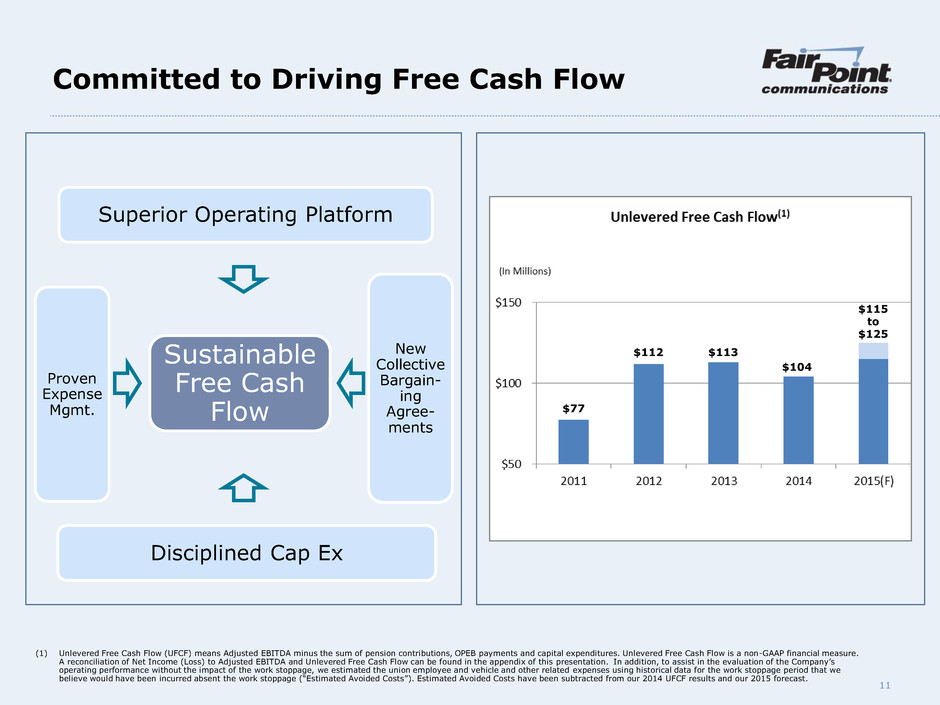
11 Sustainable Free Cash Flow Superior Operating Platform Proven Expense Mgmt. Disciplined Cap Ex New Collective Bargain- ing Agree- ments Committed to Driving Free Cash Flow (1) Unlevered Free Cash Flow (UFCF) means Adjusted EBITDA minus the sum of pension contributions, OPEB payments and capital expenditures. Unlevered Free Cash Flow is a non-GAAP financial measure. A reconciliation of Net Income (Loss) to Adjusted EBITDA and Unlevered Free Cash Flow can be found in the appendix of this presentation. In addition, to assist in the evaluation of the Company’s operating performance without the impact of the work stoppage, we estimated the union employee and vehicle and other related expenses using historical data for the work stoppage period that we believe would have been incurred absent the work stoppage (“Estimated Avoided Costs”). Estimated Avoided Costs have been subtracted from our 2014 UFCF results and our 2015 forecast. $77 $112 $113 $104 $115 to $125

12

13 Appendix

14 Summary Financial Results (1) To assist in the evaluation of the Company’s operating performance without the impact of the work stoppage, we estimated the union employee and vehicle and other related expenses using historical data for the work stoppage period that we believe would have been incurred absent the work stoppage (“Estimated Avoided Costs”) (2) Adjusted EBITDA minus Estimated Avoided Costs is a non-GAAP financial measure. A reconciliation of Net Income (Loss) to Adjusted EBITDA minus Estimated Avoided Costs can be found in this appendix as well as in our second quarter 2015 earnings release furnished August 5, 2015 in a current report on Form 8-K. (3) Unlevered Free Cash Flow minus Estimated Avoided Costs means Adjusted EBITDA minus Estimated Avoided Costs minus the sum of pension contributions, OPEB payments and capital expenditures. Unlevered Free Cash Flow minus Estimated Avoided Costs is a non-GAAP financial measure. A reconciliation of Net Income (Loss) to Unlevered Free Cash Flow minus Estimated Avoided Costs can be found in this appendix of as well as in our second quarter 2015 earnings release furnished August 5, 2015 in a current report on Form 8-K. Second Quarter 2015 Results(1) Second Quarter • Operationalizing the new CBAs • Historically low trouble loads • Completing more jobs per day per tech than before the strike • Current on installation commitments • Revenue of $214.1M • Adjusted EBITDA minus Estimated Avoided Costs(2) of $63.7M for the quarter and $125.3M year-to-date • Unlevered Free Cash Flow minus Estimated Avoided Costs(3) of $30.7M for the quarter and $63.6M year-to-date • Reported positive momentum in Ethernet revenue and growth in broadband revenue quarter-over-quarter ̶ Ethernet services contributed approximately $23.5M of revenue in Q2 2015 as compared to $20.9M a year ago, an increase of 12.4% YoY ̶ Ethernet revenue was 11.0% of total revenue in Q2 2015 compared to 9.3% of total revenue in Q2 2014 ̶ Total Ethernet circuits grew by 28.0% YoY ̶ Broadband subscribers declined 4.9% YoY primarily driven by marketing pull-back ahead of and during the strike August 18, 2015 • Accepted $37.4 million in annual support from the Federal Communications Commission’s Connect America Fund to construct and operate network infrastructure and offer broadband service speeds of at least 10 Mbps download and 1 Mbps upload to approximately 105,000 locations in 14 states • Reiterated 2015 Unlevered Free Cash Flow and Capital Expenditure guidance
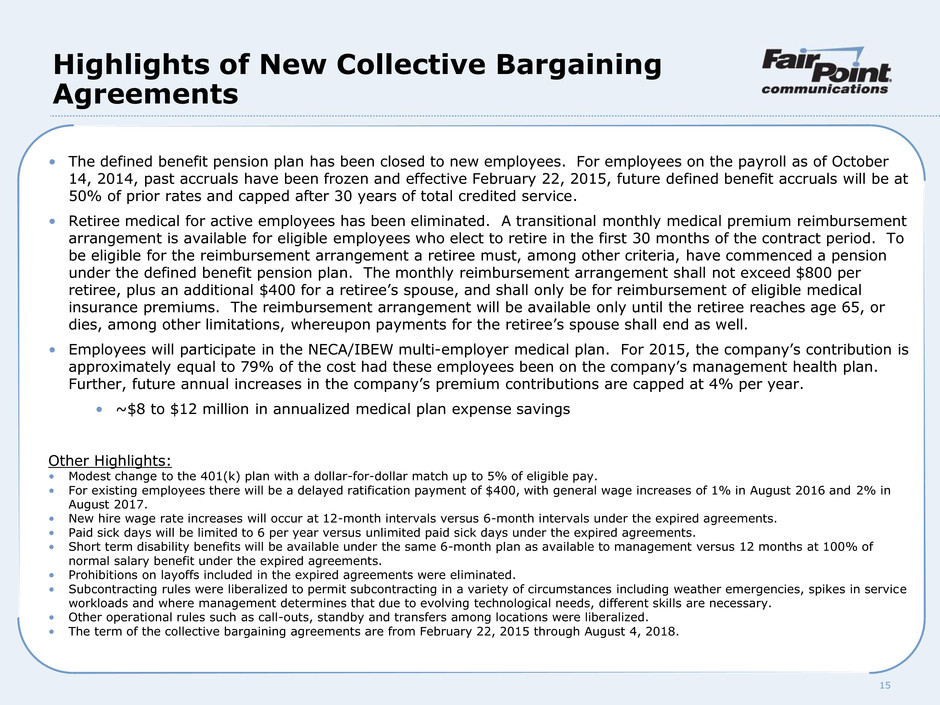
15 Highlights of New Collective Bargaining Agreements • The defined benefit pension plan has been closed to new employees. For employees on the payroll as of October 14, 2014, past accruals have been frozen and effective February 22, 2015, future defined benefit accruals will be at 50% of prior rates and capped after 30 years of total credited service. • Retiree medical for active employees has been eliminated. A transitional monthly medical premium reimbursement arrangement is available for eligible employees who elect to retire in the first 30 months of the contract period. To be eligible for the reimbursement arrangement a retiree must, among other criteria, have commenced a pension under the defined benefit pension plan. The monthly reimbursement arrangement shall not exceed $800 per retiree, plus an additional $400 for a retiree’s spouse, and shall only be for reimbursement of eligible medical insurance premiums. The reimbursement arrangement will be available only until the retiree reaches age 65, or dies, among other limitations, whereupon payments for the retiree’s spouse shall end as well. • Employees will participate in the NECA/IBEW multi-employer medical plan. For 2015, the company’s contribution is approximately equal to 79% of the cost had these employees been on the company’s management health plan. Further, future annual increases in the company’s premium contributions are capped at 4% per year. • ~$8 to $12 million in annualized medical plan expense savings Other Highlights: • Modest change to the 401(k) plan with a dollar-for-dollar match up to 5% of eligible pay. • For existing employees there will be a delayed ratification payment of $400, with general wage increases of 1% in August 2016 and 2% in August 2017. • New hire wage rate increases will occur at 12-month intervals versus 6-month intervals under the expired agreements. • Paid sick days will be limited to 6 per year versus unlimited paid sick days under the expired agreements. • Short term disability benefits will be available under the same 6-month plan as available to management versus 12 months at 100% of normal salary benefit under the expired agreements. • Prohibitions on layoffs included in the expired agreements were eliminated. • Subcontracting rules were liberalized to permit subcontracting in a variety of circumstances including weather emergencies, spikes in service workloads and where management determines that due to evolving technological needs, different skills are necessary. • Other operational rules such as call-outs, standby and transfers among locations were liberalized. • The term of the collective bargaining agreements are from February 22, 2015 through August 4, 2018.
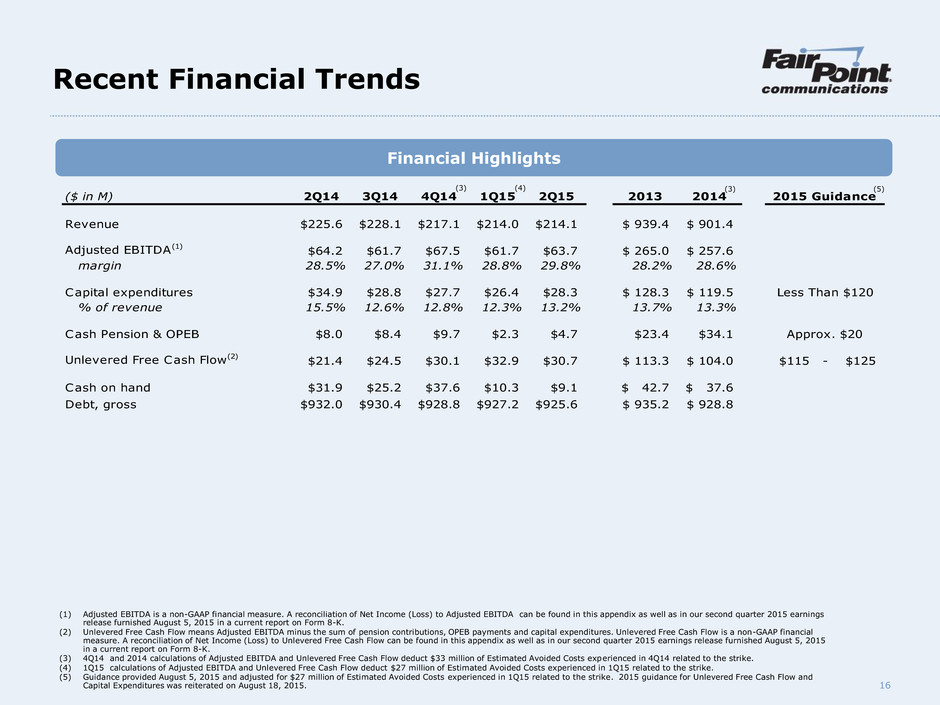
16 Recent Financial Trends (1) Adjusted EBITDA is a non-GAAP financial measure. A reconciliation of Net Income (Loss) to Adjusted EBITDA can be found in this appendix as well as in our second quarter 2015 earnings release furnished August 5, 2015 in a current report on Form 8-K. (2) Unlevered Free Cash Flow means Adjusted EBITDA minus the sum of pension contributions, OPEB payments and capital expenditures. Unlevered Free Cash Flow is a non-GAAP financial measure. A reconciliation of Net Income (Loss) to Unlevered Free Cash Flow can be found in this appendix as well as in our second quarter 2015 earnings release furnished August 5, 2015 in a current report on Form 8-K. (3) 4Q14 and 2014 calculations of Adjusted EBITDA and Unlevered Free Cash Flow deduct $33 million of Estimated Avoided Costs experienced in 4Q14 related to the strike. (4) 1Q15 calculations of Adjusted EBITDA and Unlevered Free Cash Flow deduct $27 million of Estimated Avoided Costs experienced in 1Q15 related to the strike. (5) Guidance provided August 5, 2015 and adjusted for $27 million of Estimated Avoided Costs experienced in 1Q15 related to the strike. 2015 guidance for Unlevered Free Cash Flow and Capital Expenditures was reiterated on August 18, 2015. ($ in M) 2Q14 3Q14 4Q14 1Q15 2Q15 2013 2014 2015 Guidance Revenue $225.6 $228.1 $217.1 $214.0 $214.1 939.4$ 901.4$ Adjusted EBITDA(1) $64.2 $61.7 $67.5 $61.7 $63.7 265.0$ 257.6$ margin 28.5% 27.0% 31.1% 28.8% 29.8% 28.2% 28.6% Capital expenditures $34.9 $28.8 $27.7 $26.4 $28.3 128.3$ 119.5$ Less Than $120 % of revenue 15.5% 12.6% 12.8% 12.3% 13.2% 13.7% 13.3% Cash Pension & OPEB $8.0 $8.4 $9.7 $2.3 $4.7 $23.4 $34.1 Approx. $20 Unlevered Free Cash Flow(2) $21.4 $24.5 $30.1 $32.9 $30.7 113.3$ 104.0$ $115 - $125 Cash on hand $31.9 $25.2 $37.6 $10.3 $9.1 42.7$ 37.6$ Debt, gross $932.0 $930.4 $928.8 $927.2 $925.6 935.2$ 928.8$ Financial Highlights (5) (4) (3) (3)

17 Revenue: Stabilize, Transform and Grow by Customer Segment (1) by Product Type (1)(2) (1) 2Q15 revenue of $214.1 million (2) Access includes switched access and special access, which includes wholesale Ethernet services like fiber-to-the-tower (2) Maintaining revenue transformation momentum
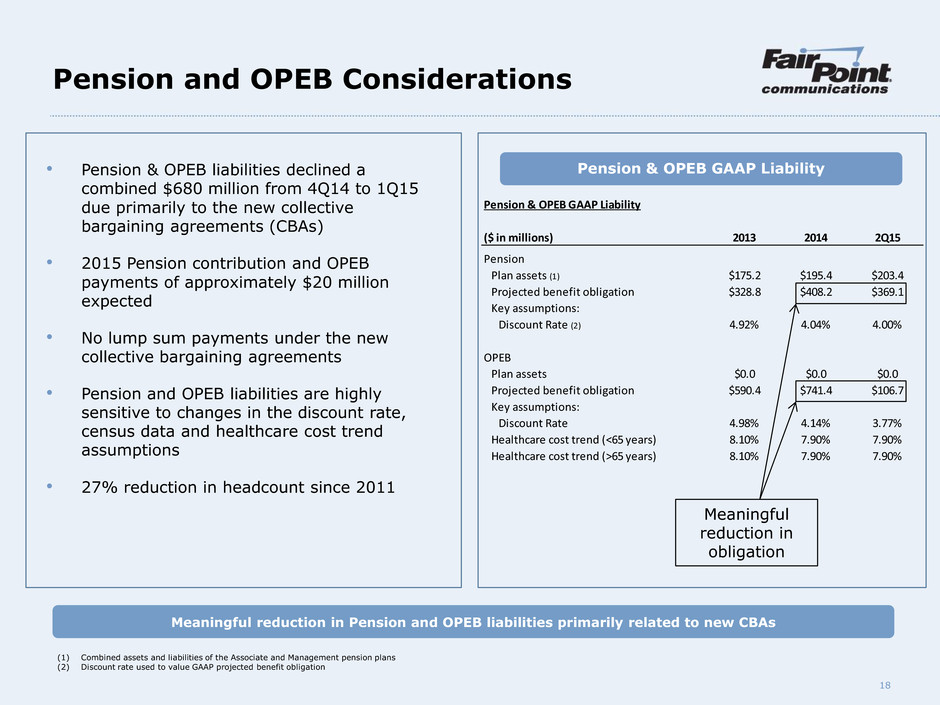
18 Pension & OPEB GAAP Liability ($ in millions) 2013 2014 2Q15 Pension Plan assets (1) $175.2 $195.4 $203.4 Projected benefit obligation $328.8 $408.2 $369.1 Key assumptions: Discount Rate (2) 4.92% 4.04% 4.00% OPEB Plan assets $0.0 $0.0 $0.0 Projected benefit obligation $590.4 $741.4 $106.7 Key assumptions: Discount Rate 4.98% 4.14% 3.77% Healthcare cost trend (<65 years) 8.10% 7.90% 7.90% Healthcare cost trend (>65 years) 8.10% 7.90% 7.90% Pension & OPEB GAAP Liability • Pension & OPEB liabilities declined a combined $680 million from 4Q14 to 1Q15 due primarily to the new collective bargaining agreements (CBAs) • 2015 Pension contribution and OPEB payments of approximately $20 million expected • No lump sum payments under the new collective bargaining agreements • Pension and OPEB liabilities are highly sensitive to changes in the discount rate, census data and healthcare cost trend assumptions • 27% reduction in headcount since 2011 (1) Combined assets and liabilities of the Associate and Management pension plans (2) Discount rate used to value GAAP projected benefit obligation Pension and OPEB Considerations Meaningful reduction in Pension and OPEB liabilities primarily related to new CBAs Meaningful reduction in obligation

19 Reconciliation of Non-GAAP Measures (1) For purposes of calculating Adjusted EBITDA (in accordance with the definition of Consolidated EBITDA in the Company's credit agreement), the Company adjusts net (loss) income for interest, income taxes, depreciation and amortization, in addition to: a) the add-back of aggregate pension and other post-employment benefits (OPEB) expense, b) the add-back (or subtraction) of the adjustment to the compensated absences accrual to eliminate the impact of changes in the accrual, c) the add-back of costs related to the reorganization, including professional fees for advisors and consultants, d) the add-back of costs and expenses, including those imposed by regulatory authorities, with respect to casualty events, acts of God or force majeure to the extent they are not reimbursed from proceeds of insurance, e) the add-back of other non-cash items, including stock compensation expense, except to the extent they will require a cash payment in a future period, and f) the add-back (or subtraction) of other items, including facility and office closures, labor negotiation expenses (including losses related to disruption of operations), non-cash gains/losses, non-operating dividend and interest income and other extraordinary gains/losses. (2) On October 17, 2014, two of our labor unions in northern New England initiated a work stoppage. As a result, significant union employee and vehicle and other related expenses related to northern New England were not incurred between October 17, 2014 and February 24, 2015 (the "work stoppage period"). Therefore, to assist in the evaluation of the Company's operating performance without the impact of the work stoppage, we estimated the union employee and vehicle and other related expenses using historical data for the work stoppage period that we believe would have been incurred absent the work stoppage ("Estimated Avoided Costs"). Estimated Avoided Costs is a pro forma estimate only. Reconciliation of Adjusted EBITDA and Unlevered Free Cash Flow from Net (Loss) Income: 2011 2012 2013 2014 2Q14 3Q14 4Q14 1Q15 2Q15 Net Income/(loss) 171,962$ (153,294)$ (93,450)$ (136,319)$ (22,680)$ (37,778)$ (43,624)$ (45,213)$ 40,265$ Income tax (benefit)/expense 226,613 (95,560) (90,291) (29,778) (7,134) (11,249) (1,725) 901 (824) Interest expense 73,128 67,610 78,675 80,371 20,023 20,195 20,145 19,819 19,974 Depreciation and amortization 358,406 376,614 282,438 220,678 55,080 56,618 54,909 55,306 55,818 Pension expense (1a) 12,185 17,809 26,221 18,144 4,754 4,892 3,699 5,111 3,088 OPEB expense (1a) 39,601 50,875 54,469 57,138 13,404 14,941 15,264 (12,008) (55,548) Compensated absences (1b) (462) 329 431 2,848 (3,013) (3,829) (1,623) 12,237 (3,803) Severance 8,006 6,380 8,150 2,005 129 264 1,228 358 3,760 Restructuring costs (1c) 21,053 1,335 207 104 47 12 27 7 20 Storm expenses (1d) 4,040 3,000 2,598 145 (190) - 745 - - Other non-cash items, net (1e) (651,943) 3,518 1,902 2,087 (109) 331 734 2,733 1,780 Loss (gain) on sale of assets - - (10,757) 450 243 170 27 - - Loss on debt refinancing - - 6,787 - - - - - - Labor negotiation expense - - 648 73,590 3,700 17,142 51,335 49,528 (850) All other allowed adjustments, net (1f) (1,055) (675) (2,998) (889) (20) (14) (671) (99) (16) Adjusted EBITDA 261,534$ 277,941$ 265,030$ 290,574$ 64,234$ 61,695$ 100,470$ 88,680$ 63,664$ Estimated Avoided Costs (2) - - - (33,000) - - (33,000) (27,000) - Adjusted EBITDA minus Estimated Avoided Costs (2) 261,534$ 277,941$ 265,030$ 257,574$ 64,234$ 61,695$ 67,470$ 61,680$ 63,664$ Adjusted EBITDA 261,534$ 277,941$ 265,030$ 290,574$ 64,234$ 61,695$ 100,470$ 88,680$ 63,664$ Pension contributions (6,178)$ (17,850)$ (19,971)$ (28,266)$ (6,895)$ (7,038)$ (7,373)$ (1,200)$ (3,182)$ OPEB payments (1,763)$ (3,183)$ (3,470) (5,808) (1,068) (1,398) (2,280) (1,149) (1,486) Capital expenditures (176,125)$ (145,066)$ (128,298) (119,489) (34,900) (28,798) (27,714) (26,430) (28,298) Unlevered Free Cash Flow 77,468$ 111,842$ 113,291$ 137,011$ 21,371$ 24,461$ 63,103$ 59,901$ 30,698$ Estimated Avoided Costs (2) - - - (33,000) - - (33,000) (27,000) - Unlevered Free Cash Flow minus Estimated Avoided Costs (2) 77,468$ 111,842$ 113,291$ 104,011$ 21,371$ 24,461$ 30,103$ 32,901$ 30,698$ Year Quarter
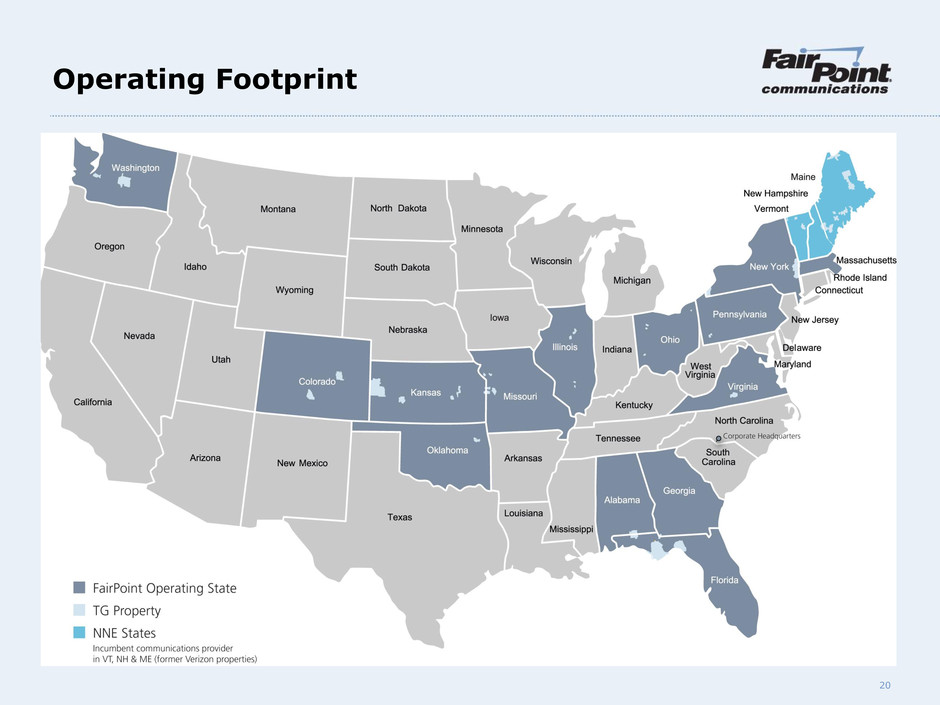
20 Operating Footprint
